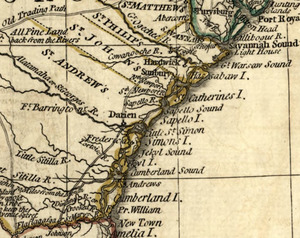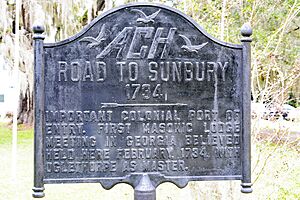Sunbury, Georgia facts for kids
Quick facts for kids
Sunbury, Georgia
|
|
|---|---|
|
Ghost town
|
|
| Country | United States |
| State | Georgia |
| County | Liberty |
| Elevation | 20 ft (6 m) |
| Time zone | UTC-5 (Eastern (EST)) |
| • Summer (DST) | UTC-4 (EDT) |
Sunbury is a ghost town located in Liberty County, Georgia. It was founded in 1758 and grew into an important port. However, by the mid-1800s, most people had left the town.
Sunbury was built on the south bank of the Midway River. Europeans first settled this area in the 1750s. The town quickly became a key seaport for the Province of Georgia. It was even a rival to the bigger city of Savannah.
During the American Revolutionary War, American soldiers defended Sunbury from Fort Morris. But British forces captured both the town and the fort in 1779. Near the end of the war, the British burned Sunbury.
After the war, the town struggled to recover. It lost its status as the county seat in the 1790s. Sunbury also faced a serious yellow fever outbreak and two strong hurricanes. What little was left of the town was destroyed in 1864. This happened during Sherman's March to the Sea in the American Civil War.
Contents
Sunbury's History
How Sunbury Began
The area where Sunbury would be built was first settled in 1752. Families from the British Province of South Carolina moved there. They chose a spot on the south bank of the Midway River. This was a high area, several miles from St. Catherine's Sound.
In 1757, King George II of Great Britain gave 500 acres of this land to Mark Carr. He was a wealthy military officer. Carr sold some of his land to others. Soon, several wharves (docks) and a trading post were set up along the river.
Founding the Town
On June 20, 1758, Mark Carr and other men decided to create a town. Carr planned much of the new town. He designed its layout and decided on the building style. He also set the price for each land lot.
The town had 496 lots, each 70 feet by 130 feet. These lots surrounded three town squares: King's Square, Meeting Square, and Church Square. This layout was similar to Savannah, Georgia's unique system of squares. Buildings in Sunbury were made of wood and tabby concrete (a mix of lime, sand, and shells).
Sunbury was the first and only town in Saint John's Parish. This area is now Liberty County, Georgia. Another settlement nearby was Midway, founded around 1752 by New England Puritans. These Congregationalists had moved from Dorchester, South Carolina. They became important to Georgia's economy, mainly by farming rice.
The town was named Sunbury, likely after Carr's family home in England. The harbor next to Sunbury was called Sunbury Channel. A small stream nearby is still known as Sunbury Creek.
A Busy Port Town
When it was founded, Sunbury had five wharves. Local merchant companies used these to buy goods from Savannah. They brought them to Sunbury by sloops (small ships). In 1761, Sunbury became Georgia's second port of entry. It quickly grew in importance, almost as much as Savannah.
In 1763, Georgia's governor, James Wright, wrote about Sunbury. He said it was a "well settled place" with a "very good harbor." He noted it had 80 houses and many stores. These stores supplied the town and nearby farms. He also said the area around Sunbury was "one of the best settled parts of the country."
Sunbury had a shipyard and made shingles and staves (wood for barrels). A causeway (raised road) connected it to Colonels Island. This island was a key place for making Indigo dye. Enslaved people helped repair this causeway every year.
The town and island also had a big lumber industry. They sent wood to other ports, including those in the West Indies. Many immigrants came to Sunbury, including people from Bermuda. In 1772, 56 ships visited the port. Enslaved people from Africa also arrived at one of the wharves.
Many plantation owners had houses in Sunbury. They lived there during the summer and fall. In 1773, the naturalist William Bartram visited Sunbury. He described it as "beautifully situated" with a "spacious and safe" harbor. He noted it had "water enough for ships of great burthen."
The American Revolution
Sunbury was a strong supporter of American independence during the American Revolution. Lyman Hall, who later signed the United States Declaration of Independence, lived in Sunbury. Button Gwinnett, another signer, worked as a justice in the town.
In June 1775, British officers seized a ship in Sunbury's port. It was carrying illegal goods. But a group of local people gathered at the town's liberty pole. They scared the officials, and the ship was freed.
Fort Morris protected Sunbury. It was built in 1756 to defend settlers from Creek Indians. During the war, Colonel John McIntosh famously told the British to "Come and take it" when they demanded the fort's surrender.
However, in 1779, British forces captured both the fort and the town. They controlled the area for the rest of the war. The British renamed the fort "Fort George" and later "Fort Defense." George Walton, another Declaration signer, was held there as a prisoner of war. Around 1781, Sunbury had about 1,000 residents and many businesses. But when the British left near the war's end, they burned both the town and the fort.
After the Revolution
After the war, in 1784, Sunbury became the first county seat for Liberty County. The Sunbury Academy was approved in 1788 and opened in 1793. This school was in King's Square. It operated for about 40 years and was famous in southern Georgia. Its head was The Reverend Dr. William McWhir, a friend of George Washington.
Sunbury officially became a town on December 8, 1791. In 1792, Sunbury Road was built. This road helped farmers bring their crops to the port. It connected Sunbury to Greensboro, Georgia, and was the longest road built in Georgia after the Revolution. A post office opened in 1793.
However, in the late 1790s, the county seat moved to Riceboro. In 1804, a strong hurricane hit Sunbury. By the early 1800s, the town had lost much of its trade to Savannah.
During the War of 1812, British warships blocked the Georgia coast. This hurt the economies of port cities like Sunbury. The United States Navy tried to use Sunbury's deep harbor for gunboats. But this plan failed due to problems with supplies. The state then decided to strengthen its coastal forts. Fort Morris was rebuilt and renamed Fort Defiance in 1813. By the end of the war in 1815, Sunbury's economy had greatly declined.
Sunbury's Final Years
The burning of Sunbury by the British seriously damaged its economy. The town was left in ruins and became poor. Later, a yellow fever outbreak and two major hurricanes made things even worse.
On December 8, 1841, the town's post office closed. By 1848, Sunbury was mostly abandoned. What little remained of the town was destroyed in 1864. This happened during the American Civil War as part of Sherman's March to the Sea.
Today, the Sunbury Cemetery is one of the only remaining parts of the old town. In 1957, the Georgia Historical Commission put up a Georgia historical marker for "Sunbury and Fort Morris." It is about 11 miles west of the ghost town in Midway.
Notable People
- James Hamilton Couper, a planter (died 1866)
- John Jones, a major (1749–1779)
- Maria Jane McIntosh, a writer (died 1878)
- John Elliott Ward, a politician and diplomat (died 1902)





